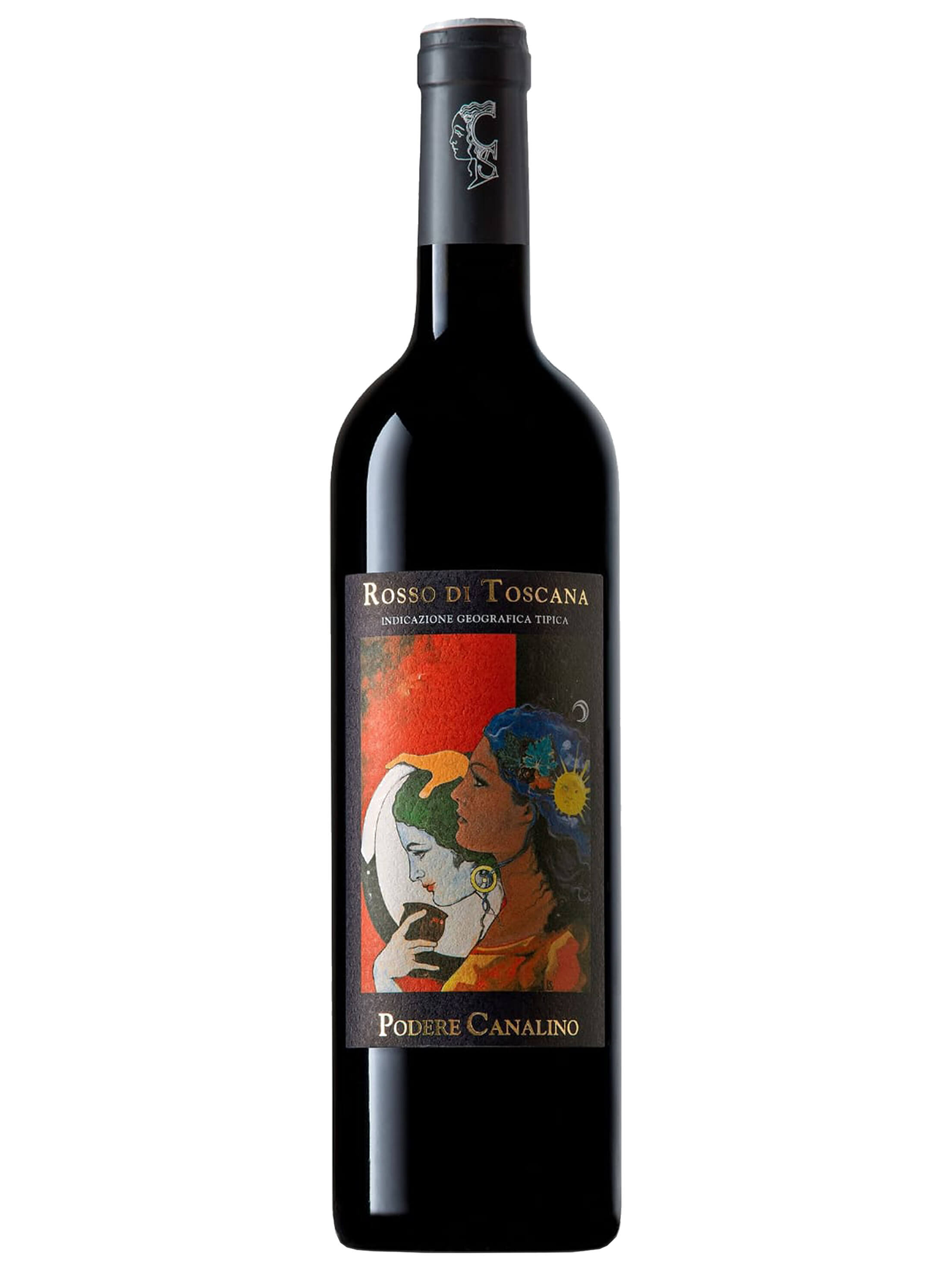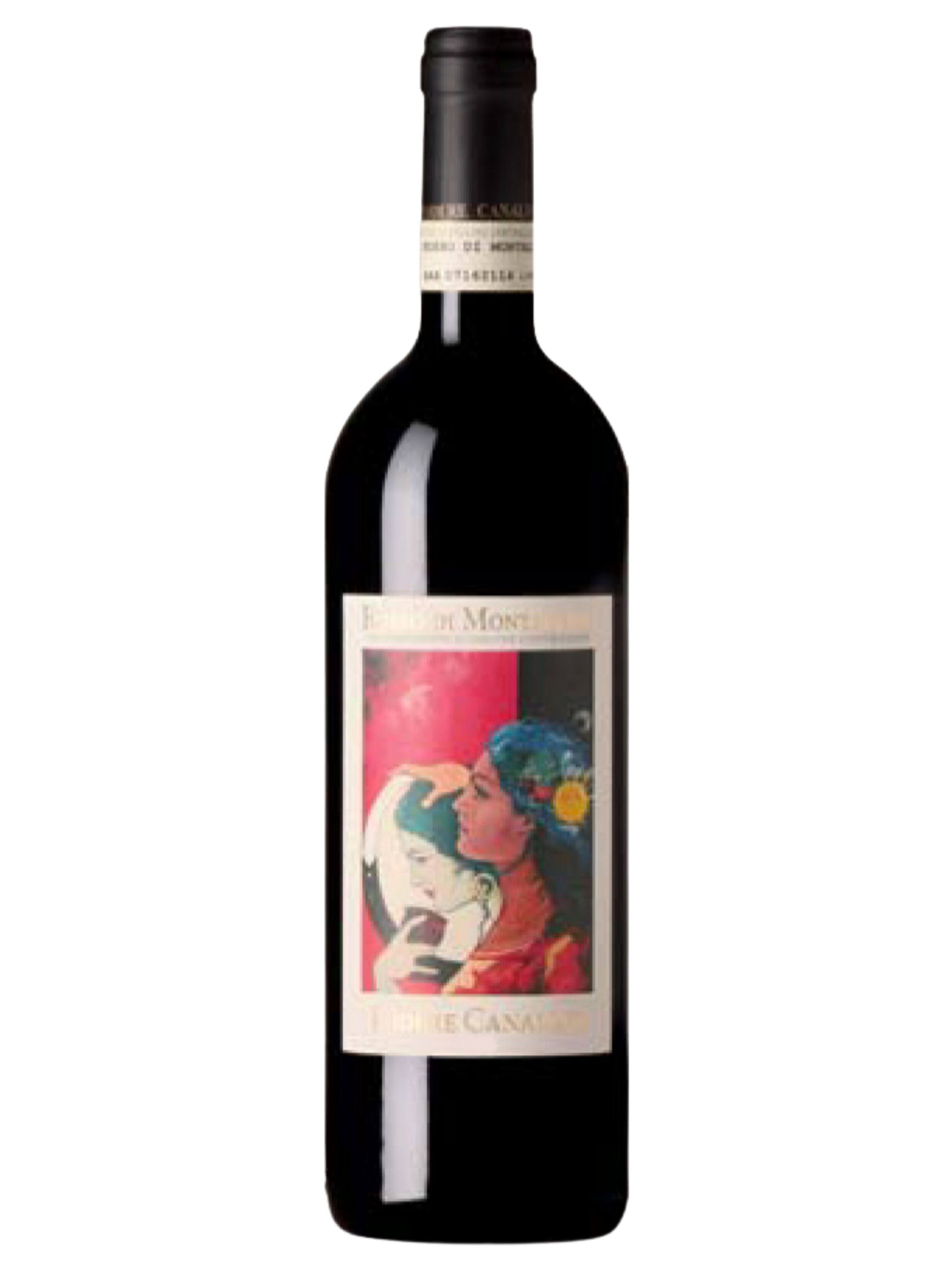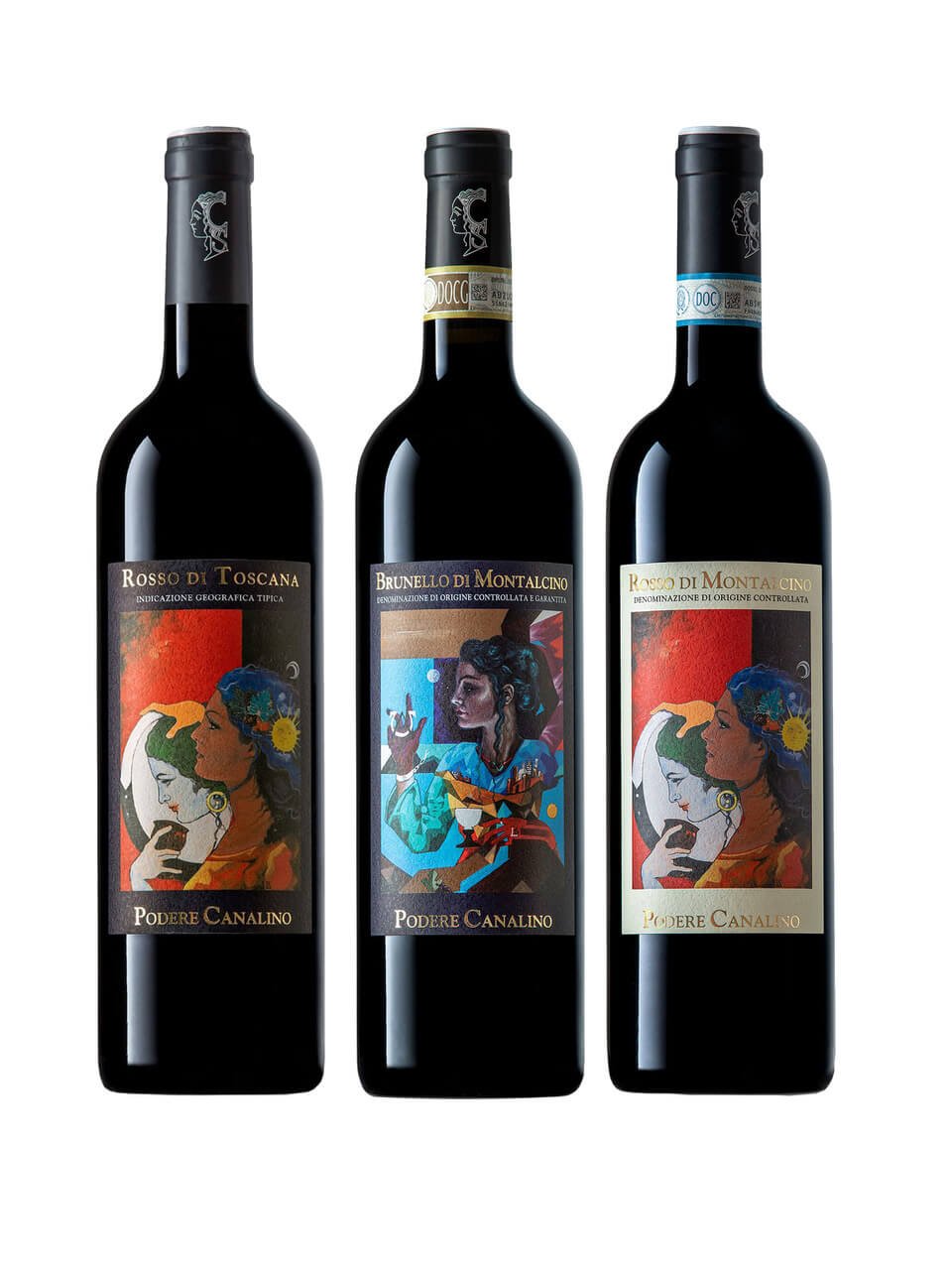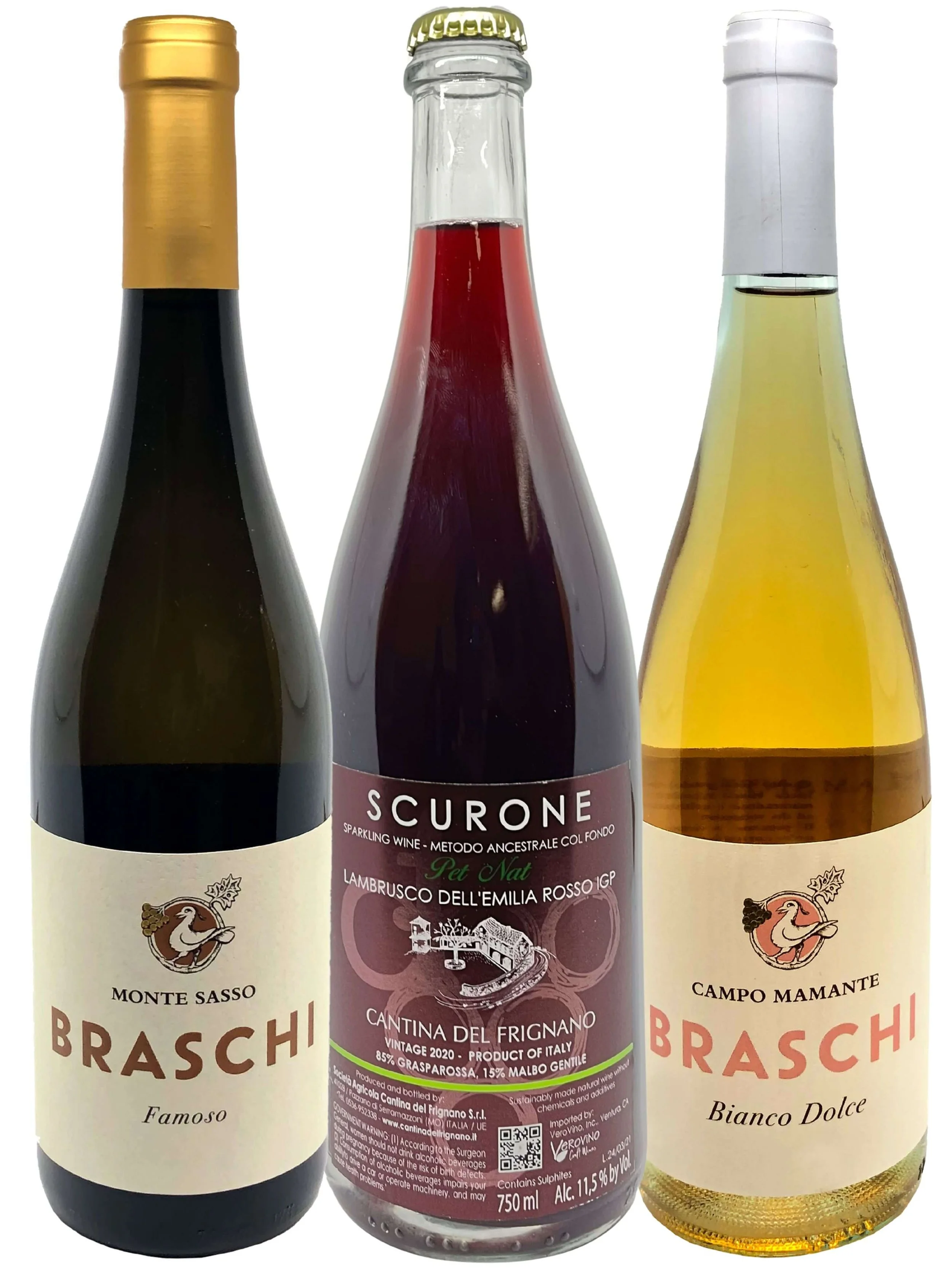The Fascinating, Multi-Faceted Sangiovese
While Sangiovese may be Italy’s most famous red wine grape, it is masked behind the names of super well known Italian wines: think Chianti and Brunello wines. Considering how popular red wines are that are made from the sangiovese grape, Italy’s most widely planted red variety, there is a lot to understand about this wine grape despite its widespread diffusion - like in almost every corner of the world you can find a Chianti, right? In fact, thanks to the popularity of Chianti wine, sangiovese is often called the Chianti grape.
But calling sangiovese the Chianti grape is way too limiting for this extraordinary wine grape. Why? Let’s find out by uncovering some fun facts about sangiovese and the delicious red wines that it makes.
Things That May Surprise You About Sangiovese
It may not come from Tuscany
If you look up Sangiovese on Wikipedia, it says ‘Notable Regions’ (plural). and then it just lists Tuscany, even though it is grown in many regions across Italy…
The origins of the sangiovese grape is a big subject of debate among wine grape historians and researchers. One common denominator, when you comb through the debates, is that you can safely conclude that the sangiovese grape is from Italy. Just don’t get in between a Toscano and Romagnolo when you debate this…
You see, even the origins of the name of the grape, Sangiovese pronounce [saan—joe-vaysee], is under debate.
Some say its name has mythological origins, meaning blood of Jove, referring to God or gods, where they credit the monks of Santarcangelo di Romagna, at the foot of Monte Giove (aka Monte Jove) in Romagna Italy, who were forced to call their wine by a different name other than vino; so they called it Sanguis Jove, a derivative of the word Sangiovese.
The grape also started to be called San Gioveto, namely in Tuscany, where later it was shortened sangioveto as per the Ampelography Commission of Siena Tuscany in 1875-1876.
Proof of the debate of the sangiovese grape name continues in 1877 with a nobleman, Giuseppe di Rovasenda, who writes about a Sangioveto in Tuscany and a Sangiovese in Romagna. It goes to show that the same grape, sangiovese, was thought to be different between Tuscany and Romagna, presumably thinking that it was a different grape all together way back then. In either case, the winelovers in Romagna won this debate with ‘sangiovese’ becoming the official name of the grape.
Either way, you get that it is a historic grape with great importance to Italy.
The Many Faces of Sangiovese Red Wine Grape
Here is Alberto Pagliantini of Canalino showing off his diagram which illustrates the process they used to select their sangiovese grosso clone and start their vineyard to make Brunello di Montalcino.
In defense of the aforementioned nobleman di Rovasenda, the grape sangiovese does have many biotypes. Just how many?… That is the source of more debates!
For starters, what is a biotype versus a clone?
According to Ian d’Agata in his book Native Wine Grapes of Italy, a biotype is a “subvariety” of the main wine grape. This means that biotypes of the same grape are related yet have differences, e.g. different physical attributes, like the shape and color of the vine leaf and grape berry.
Meanwhile a clone is not a biotype since, according to Ian, it is a cutting of a mother plant, therefore genetically identical. Yet, sangiovese has the highest number of clones registered with the Italian National Registry with over 100 showing differences, from plant appearance to winemaking results. This goes to show that there is a lot more research to do on the sangiovese grape, and also reflects the fascinating nature of this grape that has so many facets.
To simplify the sangiovese “family tree’ of biotypes, ‘they say’ to start with the 2 main sangiovese biotypes: sangiovese grosso (meaning big) and sangiovese piccolo (meaning small) and work from there.
When Vero founder, Sheila Donohue, met Alberto Pagliantini for the first time, Sangiovese winegrower of his family Tuscan winery in Montalcino, Canalino, she innocently asked ‘does your wine come from the sangiovese grosso biotype?’ Alberto, who makes Brunello wine, Rosso di Montalcino and other Sangiovese Tuscan wine(s), then pulls out a blank sheet of paper and gives her a lesson on how to choose a clone and then plant it to create a new vineyard. His passion and enthusiasm oozed as he continued to illustrate his family’s endeavor to plant sangiovese vineyards which produce Brunello Montalcino wine, one of the best red wines in the world.
Don’t judge a red wine by its color
The sangiovese grape generally produces lighter colored red wines, despite the grape having the capability of producing bold and highly structured red wines. Why is that?
Again, referring to Italian wine expert, Ian d’Agata, author of Native Wine Grapes of Italy, the sangiovese grape is rich in cyanin, one of the 5 types of anthocyanins, or pigments, that give grapes and wine their color. Cyanin is one of the least stable of these pigments, meaning that it easily breaks down, thus giving the red wine less color. Fun fact, also nebbiolo, the grape used to produce Barolo wine, also has this ‘issue.’
We say issue because many assume that the darker the red wine the better it is. But this is not the case. Coincidentally, 2 of the, arguably, best red wines that Italy produces, like wine Barolo and Brunello, both have this unstable cyanin pigment. There you go: the Italian red wine best naturely produces lighter colored red wines. See, you can’t judge a book by its cover!
Aromas and flavors of Sangiovese red wines
The red pin is showing where the Sangiovese grape comes, near Modigliana in Emilia Romagna, close to the Tuscan border, according to research books that Davide Castagnoli of Braschi read.
The predominant aroma and flavor you get in Sangiovese red wines is cherry. This is considered a primary aroma and flavor meaning that the cherry flavor comes directly from the grape itself, independent of how the wine was made.
Meanwhile during fermentation other aromas and flavors come out, like floral scents of violet, although this can vary depending on where it is grown and if and what selected yeasts are used, aging vessels, and other winemaking decisions, like to use new versus neutral oak. (primary vs secondary refer to wine tasting article). Tea leaf is another common aroma. Preferably, you’d want to get some earthy notes, which also usually indicates that it is a natural wine. To learn more about primary versus secondary aromas in wine, check out this article.
It can make different styles of red wines
Sangiovese red wines can vary from light and juicy to bold and structured.
In addition to there being many different biotypes and clones of sangiovese grapes, what gives Sangiovese wine another element of surprise is the grape’s disposition to be site sensitive. Depending on where it is grown, it will produce a different style of wine… and there is a double edged sword: if planted in the wrong place, the wines are not that good.
Let’s get a take on Sangiovese from an Italian Winery
Davide Castagnoli of Braschi winery in Romagna enjoying a Sangiovese with a traditional Romagnolo meal.
To learn more about Sangiovese, we spoke with the Braschi boys, owners Davide Castagnoli and Vincenzo Vernocchi, who is also winemaker, to get their take on the grape and wine Sangiovese.
A guy with deep roots in Romagna Italy, aka a Romagna DOC
First, we sat down with die-hard Romagnolo, Davide Castagnoli of Braschi winery in Romagna Italy, to get his take on Sangiovese.
Why do you like Sangiovese, the grape & wine?
The sangiovese grape makes pure and satisfying red wines that are easy to drink yet have good structure, in particular tannins.
Sangiovese wines pair well with our local dishes, which we call ‘Romagnolo Toscano,’ or Romagna Tuscan dishes, since, even though we are in Romagna, we are also close to Tuscany, so we share not only the same grape and wine (Sangiovese) but we also have a similar cuisine.
What’s your take on the origin of the Sangiovese grape?
My reference are 2 books with clear sources that indicate that the Sangiovese was first written about first in the 1500s. Its origins are between Romagna and Tuscany, specifically in the area around Modigliana in Emilia Romagna, just north of Tuscany. (Note: there are non documented sources indicating that sangiovese, as a wild vine plant, was cultivated by the Etruscans during pre-Roman times.)
The grape was called Sangiovese in Romagna and Sangioveto in Tuscany until at a certain point the Tuscans transitioned to using the name Sangiovese, although to this day you still here certain people still using the term sangioveto.
What is your take on the differences between Sangiovese red wine from Tuscany vs Romagna?
Vicenzo Vernocchi, winemaker of Braschi, walking through one of their sangiovese vineyards just north of Tuscany, in Romagna.
The main aspects which will cause variations between one Sangiovese red wine and another is the type of clone and the terroir (soil, weather, etc.) We at Braschi make a Sangiovese in the mountains just north of Tuscany. That Sangiovese is similar to a Tuscan Sangiovese, meaning that it is smoother, with rounder tannins. Meanwhile, if you go to the areas where Sangiovese vines are typically grown in Romagna, the altitude is lower and the soil is different, usually a clay loam soil, resulting in Sangiovese wines with both tannins and acidity that are more pronounced than Tuscan style Sangiovese red wines.
Perspectives from a Sangiovese winemaker
To get a little more technical about the differences between Sangioveses from Tuscany versus Romanga, we also talked to Davide’s business partner, Vincenzo Vernocchi, winemaker of Braschi, who also has been a winemaker and consultant to several Tuscan wineries.
What’s your take on the differences between Sangiovese red wines from Tuscany and Romagna?
The main drivers which cause differences in Sangiovese red wines, independent of where they are grown, is climate and soil. Which biotypes or clones are used has become less of a factor over the past 30 years with many winegrowers in both Tuscany and Romagna deciding to use the same clones, e.g. R24 which was cited as being one of the clones that produces the best quality Sangiovese red wines.
For example, Romagna has a colder climate than Tuscany, to its south. That produces a Sangiovese di Romagna red wine that is higher in acidity, with a more floral profile, and harsher tannins, which require more maturation on the vine. Meanwhile, Tuscany is considered a hotter climate, producing fruitier Sangiovese red wines, which can also come with challenges to introduce structure, like acidity.
What are the effects of soil when making Sangiovese red wines?
You find different soil everywhere, even in Romagna which has many different types of soil. One reason Bertinoro (a ‘commune’ in Romagna) is known for making such great Sangiovese red wines is because it has less clay (which is considered a fertile soil) and more limestone and sand, which yields great fruit. The more ‘poor’ the soil (i.e., with less nutrients) the more the vine goes into stress, producing a better wine.
Sangiovese Food Pairings
Fresh off our publication of a recipe for Pappardelle con Cinghiale, or Pasta with Wild Boar Sugo, which is considered Tuscany’s National Dish, we heartily recommend pairing Sangiovese red wine, either from Tuscany or Romagna, with this rich and tasty pasta dish. Likewise, you could consider making a Tuscan beef stew, using this recipe, and pair it with a wine of Tuscany made from Sangiovese. Other Tuscan inspired food pairing ideas are in this article, inspired by Sangiovese red wines from Montalcino, like this wine Brunello, which Alberto Pagliantini grows and makes at his biodynamic winery in Montalcino. All of his wines are organic, biodynamic and natural wines.
In our article ‘Dine like a Romagnolo’ featuring Davide Castagnoli from Braschi, we actually featured a recipe from one of the dishes that Davide mentions as one of his favorite food pairings with Sangiovese red wine: capretto, or oven roasted goat. Other foods which Davide loves to pair with Sangiovese red wine is lasagna, salumi (think charcuterie!), aged cheeses (check out some suggestions here), barbecued meats, roasts, and, last but not least, brodetto di pesce or fish stew.
In fact, Davide went on to explain that brodetto di pesce was a typical meal for fisherman in Romagna, whose culture and lifestyle was and continues to be heavily influenced by the Adriatic Sea, which it borders. “Traditionally, going back 50 years and more, fisherman only drank cold red wine (aka Sangiovese) and they would pair it with a stew made from their daily catch of the day, hence how brodetto di pesce came about,” says Davide.
Explore Different Types of Sangioveses
Vero was ‘born’ to have you be exposed to different wines, whether it is a grape you never had, a wine producer or place you never heard of or different expressions of the same wine grape.
Hence, we have an eclectic selection of Sangiovese red wines, ranging from
traditional Tuscan Sangiovese red wines from the heart of Montalcino, including the ‘king’, Brunellos wine.
Further to the southwest, is the wild Maremma and the natural wine estate by woman winemaker Antonella Manuli of La Maliosa who practices regenerative farming making all organic wine and biodynamic wine. You gotta try her Tarconte, a delicious Sangiovese natural red wine from her estate which makes exclusively organic wine and biodynamic wine as well as organic extra virgin olive oils.
Last but not least, try Braschi’s Sangiovese red wines from Romagna to taste the difference for yourself between Tuscan and Romagnaolo sangioveses!
As a reminder, we sell nature wines and organic EVOO to both businesses and consumers across the US:
We are enlarging our network of distributors around the country. Reach out to us if you are interested in distributing our wines.
We sell to wine stores and restaurants in certain states - contact us if you would like more info.
We do corporate gifts and sommelier guided wine tastings. Email us and we’ll tailor unique and sustainable corporate gift ideas.
If our farm crafted wines and olive oils are not in your local shop or restaurant buy wine online here where we ship to most states.
We also have an award winning wine club for true wine explorers seeking to continually discover unique, sustainable and authentic small production wines they never had.











